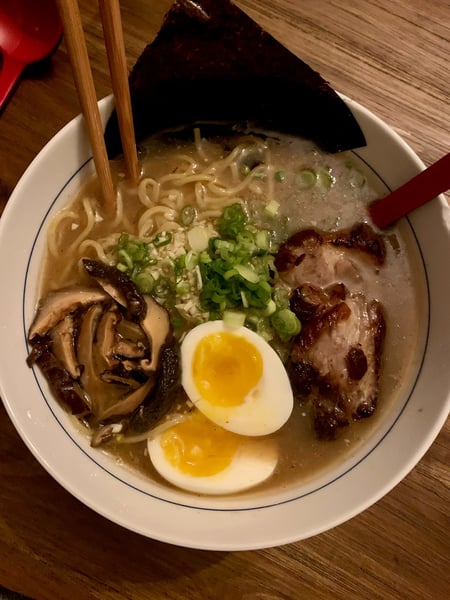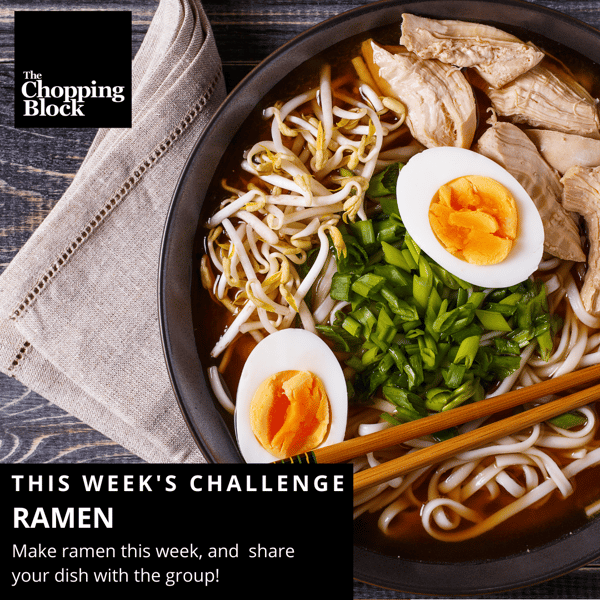Ramen 101

Ramen is a noodle soup dish that was originally imported from China and has become one of the most popular dishes all over the world. You may only know ramen from your college days of the instant ramen packets that are widely found in grocery stores, but there is so much more to know about this delectable dish. When you boil it down, pun intended, all you need to make ramen at home is a really flavorful broth, noodles that you can slurp and any garnishes you like.
Ramen Broth
Ramen is typically categorized according to the soup base, although variations that combine the different bases are not uncommon. That is the fun of making your own! It can completely be customizable to your own preferences.
The main types of soup bases are:
- Paitan: This type of broth is opaque, full of fat and silky in texture due to gelatin, which forms when the collagen-rich connective tissue is cooked at a high temperature.
- Chintan: This type of broth is clear, with a lighter mouthfeel, and it is often cooked at a lower temperature. Chintan chicken, vegetable and seafood broths are often mixed with dashi - the popular Japanese soup base made from bonito flakes and kombu or kelp - to make ramen.
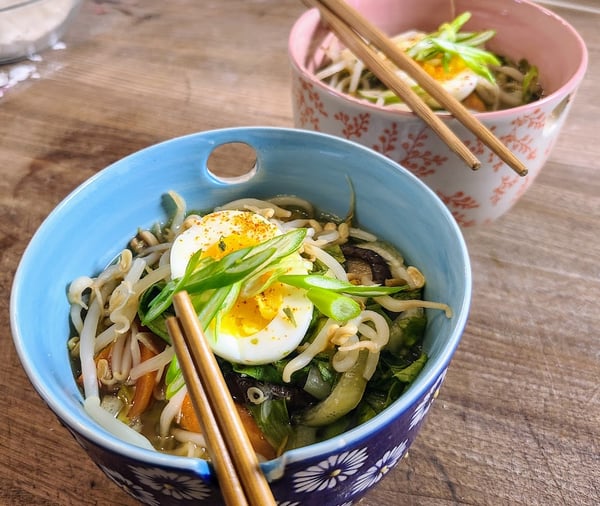 Ramen broth is often made unsalted and then mixed with tare (seasoning) to add saltiness and flavor. All across the world, chefs at ramen shops use a variety of soup bases and tares to make this comfort food staple their own. The most popular ramen seasonings or tares that you will see on most menus are listed below.
Ramen broth is often made unsalted and then mixed with tare (seasoning) to add saltiness and flavor. All across the world, chefs at ramen shops use a variety of soup bases and tares to make this comfort food staple their own. The most popular ramen seasonings or tares that you will see on most menus are listed below.
Shoyu (Soy Sauce)
Shoyu ramen soup is a clear, brown broth flavored with soy sauce (shoyu). The soup is usually made of chicken broth but often contains other meats such as pork, beef or fish depending on the region. Shoyu ramen is the most common type of ramen and is usually what is served when the menu does not specify a specific type of soup.
Shio (Salt)
Shio ramen soup is a light, clear broth seasoned with salt. It is typically made from chicken broth, but may also be flavored with other meats such as pork.
Miso (Soybean Paste)
Miso ramen soup is flavored with soybean paste (miso), resulting in a thick, brown soup with a rich, complex flavor. The style originated in Hokkaido where the long cold winters spurred the need for a heartier type of ramen soup, but it has spread to the point where it can be found pretty much anywhere in Japan.
Tonkotsu (Pork Bone)
Particularly popular around Kyushu, tonkotsu ramen is made of pork bones which have been boiled down until they dissolve into a cloudy white broth. The thick, creamy soup is also often flavored with chicken broth and pork fat.
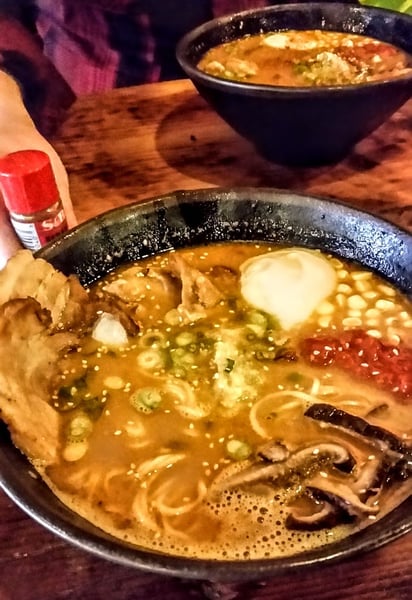
Ramen Noodles
The second key aspect of ramen are of course, the noodles. Typical ramen noodles are long and elastic, but countless varieties exist that vary from thin and straight to thick and wavy. The noodles are springy, yellow, wheat-flour noodles and they get their yellowish color from kansui, which is an alkaline mineral water.
In Japan, ramen shops serve noodles with a variety of thicknesses and textures, but they originated in China as soba noodles. When making your own ramen noodles at home, it may be hard to procure kansui so an easy substitute would be to bake 1/2 cup of fresh baking soda at 250° for one hour. If you bake baking soda, it changes from sodium bicarbonate to sodium carbonate—an alkaline salt and when mixed with water and flour will yield a very close to the real deal noodle dough.
Here is The Chopping Block's recipe for ramen noodles using baking soda instead of kansui.
Homemade Ramen Noodles
Scroll down for a printable version of this recipe
Yield: 4-6 servings
Active time: 45 minutes
Start to finish: 1 hour, 5 minutes
4 teaspoons baked baking soda (see note, below)
1/2 cup warm tap water
1/2 cup cold tap water
3 cups all-purpose flour
To Make the Dough:
1. Place the baked baking soda in a large bowl. Add the 1/2 cup warm water to dissolve the soda.
2. Add the 1/2 cup cold water and the flour. Stir to make a crumbly dough.
3. Aggressively knead the dough on a lightly-floured work surface until the dough begins to smooth out. The texture of this dough is quite tough.
4. Wrap the dough in plastic wrap, and allow to rest for 20 minutes at room temperature.
5. Cut the dough into six equal pieces. Cover the dough you are not using with plastic wrap to prevent it from drying out.
To Roll the Dough:
1. Set up a pasta roller with a cutter attachment.
2. Flatten one portion of dough with the palm of your hand, making it easier to fit through the pasta machine.
3. If the dough is at all sticky, dust it with a sprinkle of flour to prevent it from sticking in the pasta roller.
4. Pass the dough through the pasta roller on the widest setting. Fold the dough into thirds, and roll it through the widest setting again. Continue in this fashion until the dough is smooth.
5. Increase the roller setting by one increment, and pass the strip of dough through once. Continue passing the dough through each setting, up through number five.
6. If the sheet of dough is quite long, cut it into 8- to 10-inch sections.
7. Move the handle from the rollers to the fine (spaghetti) cutter, and cut the dough into noodles. You can also cut the dough by hand.
8. Transfer the noodles to a floured sheet tray.
9. Repeat the same process with the remaining balls of dough.
10. To cook the noodles, bring a large pot of salted water to a boil. Boil the noodles in batches for 2 to 3 minutes, or until tender. Drain well, rinse in cold water, and use in your favorite ramen recipes.
Note: To make authentic alkaline noodles, one needs kansui or packaged alkaline salts. You might find
kansui in your local Chinatown or online, but it typically is sold in large quantities that may not be
practical for the home cook. Harold McGee, author of On Food & Cooking: The Science & Lore of the
Kitchen, discovered that if you bake baking soda, it changes from sodium bicarbonate to sodium
carbonate—an alkaline salt. Bake 1/2 cup of fresh baking soda at 250° for one hour.
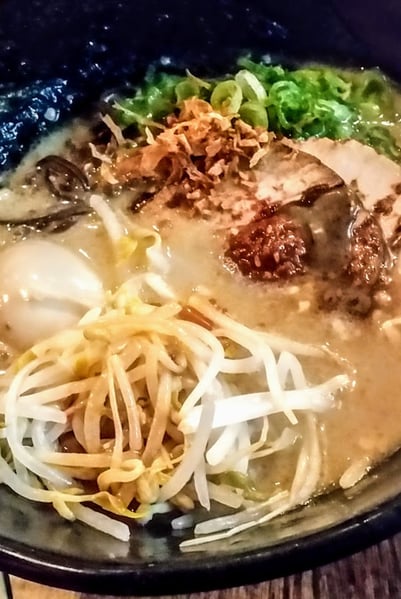
Toppings
The last step to completing your bowl of ramen is the wide assortment of toppings that provide more flavors and textures to the soup base and noodles. There are some ingredients that are usually served with a particular ramen soup base, but I always like experimenting and mixing and matching my garnishes. Some of my favorites that are commonly served with ramen are:
Chashu: Fatty slices of roasted or braised pork. Chashu is a very common topping, and standard bowls of ramen usually come with one or two slices of it. Kakuni or braised pork belly is served instead of chashu at some restaurants.
Negi: Chopped or shredded leeks or green onions. Karanegi is a spicy variation of shredded leeks mixed with chili oil. Negi is a ramen standard, while karanegi is often seen with miso ramen.
Moyashi: Raw or cooked bean sprouts add sweetness and crunch. Served on all types of ramen.
Eggs: Soft boiled and very jammy are easily my favorite ingredient to put in ramen. Marinated eggs are also a popular topping on any type of ramen.
Seaweed: Various types of seaweed such as wakame and nori are commonly added to all types of ramen. This gives a burst of umami flavor.
Kamaboko: Slices of steamed fish cake. One type of kamaboko that is commonly served on ramen is naruto (or narutomaki), a sawtooth edged, white fish cake with a red or pink spiral design on it.
Corn: Canned corn is often paired with butter and served on miso or shio ramen.
Butter: A thick pat of butter adds creaminess and depth. Typically added to miso or shio ramen.
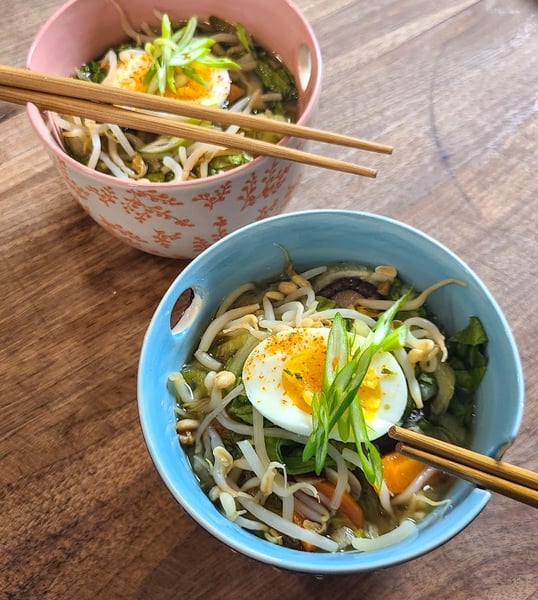 There are so many great ramen places to eat at here in Chicago, but why go out when you can make ramen at home? We have an excellent virtual ramen workshop coming up this Saturday, October 9 at 3pm CST. I would love to teach you how to make the noodles from scratch with jammy eggs and hearty broth.
There are so many great ramen places to eat at here in Chicago, but why go out when you can make ramen at home? We have an excellent virtual ramen workshop coming up this Saturday, October 9 at 3pm CST. I would love to teach you how to make the noodles from scratch with jammy eggs and hearty broth.
Ramen also happens to be this week's challenge for our private Facebook group members. Join, make some ramen this week in our virtual class (or on your own) and share your creations with other home cooks.
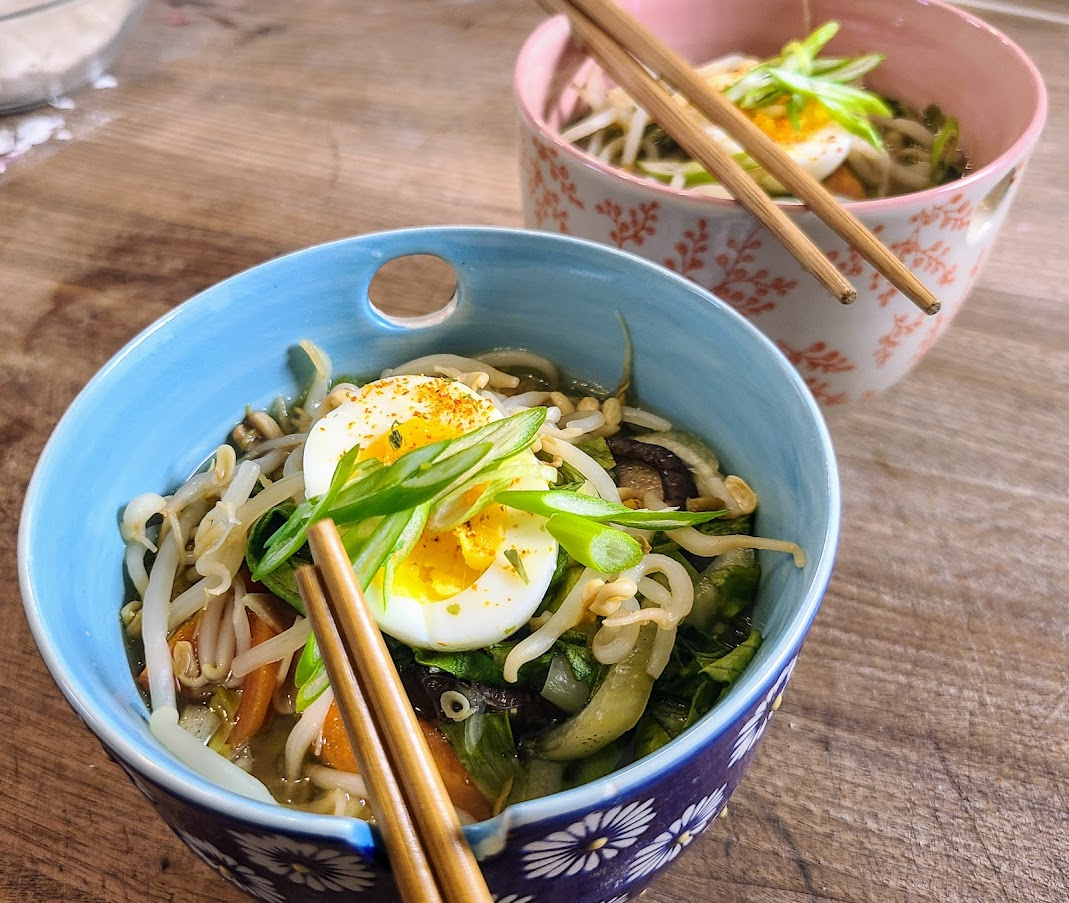
Homemade Ramen Noodles
Ingredients
- 4 teaspoons baked baking soda (see note, below)
- 1/2 cup warm tap water
- 1/2 cup cold tap water
- 3 cups all-purpose flour
Instructions
- Place the baked baking soda in a large bowl. Add the 1/2 cup warm water to dissolve the soda.
- Add the 1/2 cup cold water and the flour. Stir to make a crumbly dough.
- Aggressively knead the dough on a lightly-floured work surface until the dough begins to smooth out. The texture of this dough is quite tough.
- Wrap the dough in plastic wrap, and allow to rest for 20 minutes at room temperature.
- Cut the dough into six equal pieces. Cover the dough you are not using with plastic wrap to prevent it from drying out.
- Set up a pasta roller with a cutter attachment.
- Flatten one portion of dough with the palm of your hand, making it easier to fit through the pasta machine.
- If the dough is at all sticky, dust it with a sprinkle of flour to prevent it from sticking in the pasta roller.
- Pass the dough through the pasta roller on the widest setting. Fold the dough into thirds, and roll it through the widest setting again. Continue in this fashion until the dough is smooth.
- Increase the roller setting by one increment, and pass the strip of dough through once. Continue passing the dough through each setting, up through number five.
- If the sheet of dough is quite long, cut it into 8- to 10-inch sections.
- Move the handle from the rollers to the fine (spaghetti) cutter, and cut the dough into noodles. You can also cut the dough by hand.
- Transfer the noodles to a floured sheet tray.
- Repeat the same process with the remaining balls of dough.
- To cook the noodles, bring a large pot of salted water to a boil. Boil the noodles in batches for 2 to 3 minutes, or until tender. Drain well, rinse in cold water, and use in your favorite ramen recipes.

